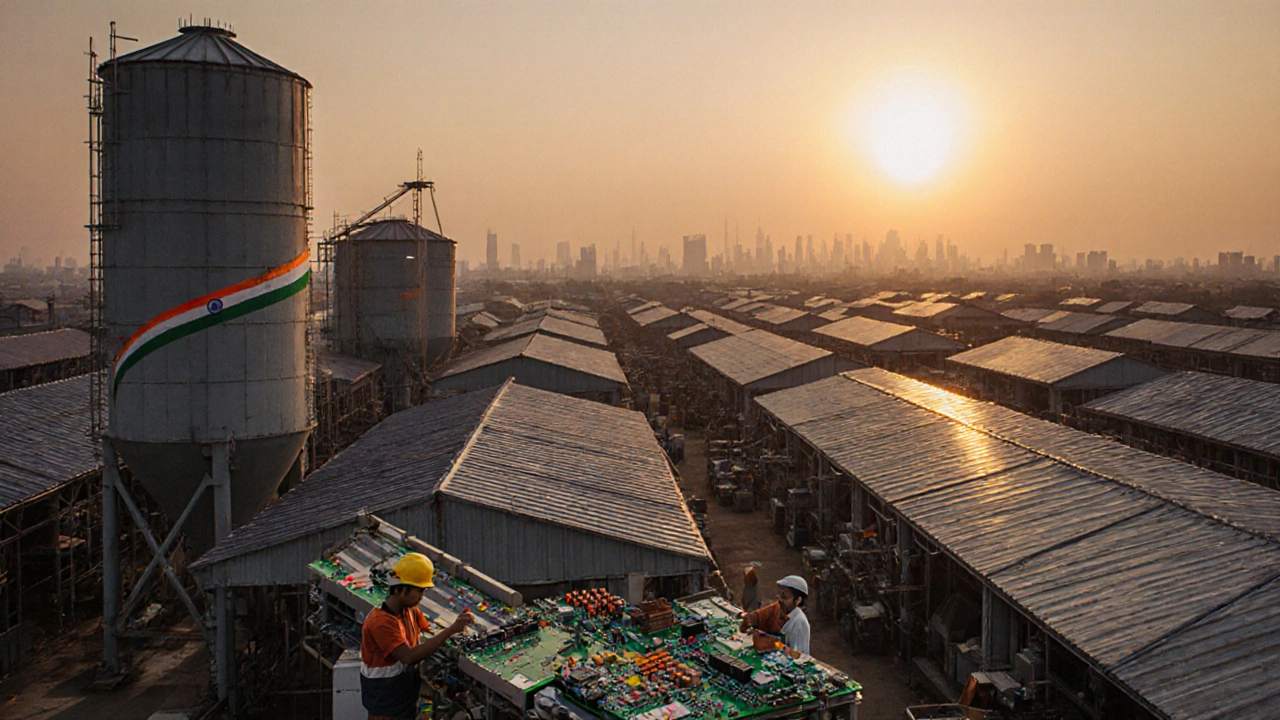India's Electronics Sector Growth Estimator
Project Your Electronics Sector Growth
Use this tool to estimate potential growth in India's electronics sector based on key metrics and government initiatives.
Projection Results
Projected Turnover:
Projected Exports:
Growth Rate:
When you hear India's electronic industry mentioned these days, the first thing that comes to mind is rapid expansion. Over the past few years, the sector has moved from modest output to a powerhouse that’s reshaping the global supply chain. This article unpacks the numbers, the policies, and the hurdles, so you can see whether the boom is real, sustainable, and worth your attention.
India's electronic industry is a dynamic segment that covers design, assembly, testing, and export of electronic products ranging from consumer gadgets to aerospace components. It sits at the intersection of technology, manufacturing, and trade, making it a key indicator of the country’s industrial health.Key Takeaways
- Electronic goods output grew by 22% YoY in FY 2024‑25, hitting $85billion in value.
- Government schemes like Make in India and the Electronics Development Fund have channelled over $12billion into the sector.
- Semiconductor fab capacity is expected to double by 2027, thanks to greenfield projects from global players and domestic firms.
- Challenges remain: skilled‑labour shortage, raw‑material import dependence, and logistics bottlenecks.
- Export share rose to 27% of total production, positioning India as the world’s fifth‑largest electronics exporter.
2024‑25 Performance Snapshot
According to the Ministry of Electronics and Information Technology (MeitY), the sector recorded a total turnover of ₹7.1trillion (~$85billion) in FY 2024‑25. That’s a 22% increase over the previous year and the highest ever recorded. The growth was driven by three sub‑segments:
- Consumer electronics (smartphones, TVs, wearables) - 38% of total output.
- Industrial electronics (automation, robotics) - 32%.
- Semiconductor components - 15%, with the rest split between defense and healthcare devices.
Export earnings crossed $25billion, a 30% jump, led by shipments to the United States, European Union, and Southeast Asia.
Government Engines Fueling the Surge
Policy support is the backbone of the boom. Below are the flagship schemes and their concrete contributions.
- Make in India - Offers a 15% subsidy on plant & machinery for approved electronics parks.
- Electronics Development Fund (EDF) - Managed by the Department for Promotion of Industry and Internal Trade (DPIIT); disbursed $4.5billion for R&D in 2024‑25.
- Digital India Initiative - Drives demand for devices and connectivity, indirectly boosting component sales.
- GST rationalisation - Reduced tax rates on electronic components from 18% to 12%, cutting costs for manufacturers.
- Indian Electronics Association (IEA) - Acts as a liaison between industry and government, shaping standards and facilitating skill‑training programmes.
Collectively, these programmes pumped more than $12billion of capital and incentives into the sector during the last fiscal year.
Semiconductor Fabrication: The New Frontier
Semiconductors are the linchpin of modern electronics, and India has been a net importer for decades. 2024‑25 marked a turning point, with three major fab projects breaking ground:
- GlobalFoundries India - 300mm wafer fab in Gujarat, capacity 30,000 wafers per month.
- SME’s Silicon Valley‑Style Fab - 200mm line in Karnataka, focusing on analog and power ICs.
- Government‑backed Semiconductor Mission - A $3billion public‑private partnership targeting 100% domestic sourcing of critical chips by 2030.
These plants are expected to add ~45% to India’s fab capacity by 2027, cutting import bills and attracting design‑out engineering services.
Comparative Outlook: 2023 vs 2025
| Metric | FY 2023 | FY 2025 | Growth |
|---|---|---|---|
| Total Turnover (USD) | 69billion | 85billion | +23% |
| Exports (USD) | 19billion | 25billion | +32% |
| Semiconductor Fab Capacity (kWafers/month) | 10,000 | 15,000 | +50% |
| Employment (jobs) | 750,000 | 1,050,000 | +40% |
The table shows that revenue, exports, and fab capacity have all moved upward at a healthy pace, confirming the sector’s momentum.
Key Challenges and Mitigation Strategies
Even with the bright numbers, several roadblocks could stall the surge.
- Skill Gap: The industry needs 1.2million skilled technicians by 2027. IEA partnered with technical institutes to launch 150‑day certification courses, aiming to fill 300,000 seats by 2026.
- Raw‑Material Dependence: Over 70% of high‑purity silicon still comes from imports. The Semiconductor Mission includes a raw‑material stock‑piling component to reduce import volatility.
- Logistics Bottlenecks: Congestion at major ports adds 3‑5 days to lead times. The government’s “Dedicated Freight Corridor” project is expected to cut transport time by 30% once operational in 2026.
- Regulatory Hurdles: Complex approval processes for foreign direct investment (FDI) can delay projects. Recent amendments to the FDI policy now allow 100% foreign ownership in greenfield electronics parks.
Addressing these issues is critical to turning the current surge into a long‑term growth engine.

What the Surge Means for Stakeholders
Whether you’re an investor, a supplier, or a policymaker, the implications differ.
- Investors: The sector’s CAGR (Compound Annual Growth Rate) of 18% over the last three years suggests strong upside. Venture capital is increasingly flowing into IoT and PCB design startups.
- Suppliers: Component manufacturers should consider expanding capacity for capacitors, inductors, and MEMS, as demand from domestic fabs is rising fast.
- Policymakers: Continued fiscal incentives, streamlined customs, and a national skills framework will keep the growth trajectory on track.
Future Outlook - 2026 and Beyond
Analysts from leading consultancies forecast that India will cross the $120billion mark by 2028, driven by AI‑enabled devices, electric‑vehicle electronics, and defense contracts. The government’s target of “$10billion in semiconductor exports by 2030” appears reachable if current fab projects stay on schedule.
In sum, the data points to a genuine surge, but sustaining it will require coordinated effort across policy, talent, and infrastructure.
Frequently Asked Questions
How much did India's electronics exports grow in FY 2024‑25?
Exports rose to $25billion, a 30% increase over the previous fiscal year, making electronics the third‑largest export category after gems and textiles.
What are the main government schemes supporting the electronics sector?
Key schemes include Make in India, the Electronics Development Fund, the Digital India Initiative, and GST reductions on electronic components.
When will the new semiconductor fabs become operational?
The Gujarat GlobalFoundries plant is slated for a 2026 Q3 start‑up, while the Karnataka analog fab should be online by early 2027.
What are the biggest challenges facing the industry today?
Skill shortages, reliance on imported raw materials, logistics bottlenecks at ports, and regulatory delays are the top hurdles. Ongoing upskilling programmes and infrastructure projects aim to mitigate these.
Is India likely to become a net exporter of semiconductors?
Analysts expect a shift to net export status by 2030, provided current fab capacity expansions stay on schedule and the supply chain becomes more localized.
